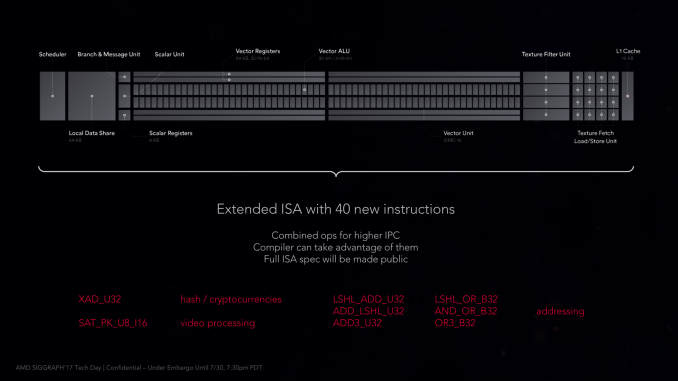The AMD Radeon RX Vega 64 & RX Vega 56 Review: Vega Burning Bright
by Ryan Smith & Nate Oh on August 14, 2017 9:00 AM ESTThe Vega Architecture: AMD’s Brightest Day
From an architectural standpoint, AMD’s engineers consider the Vega architecture to be their most sweeping architectural change in five years. And looking over everything that has been added to the architecture, it’s easy to see why. In terms of core graphics/compute features, Vega introduces more than any other iteration of GCN before it.
Speaking of GCN, before getting too deep here, it’s interesting to note that at least publicly, AMD is shying away from the Graphics Core Next name. GCN doesn’t appear anywhere in AMD’s whitepaper, while in programmers’ documents such as the shader ISA, the name is still present. But at least for the purposes of public discussion, rather than using the term GCN 5, AMD is consistently calling it the Vega architecture. Though make no mistake, this is still very much GCN, so AMD’s basic GPU execution model remains.
So what does Vega bring to the table? Back in January we got what has turned out to be a fairly extensive high-level overview of Vega’s main architectural improvements. In a nutshell, Vega is:
- Higher clocks
- Double rate FP16 math (Rapid Packed Math)
- HBM2
- New memory page management for the high-bandwidth cache controller
- Tiled rasterization (Draw Stream Binning Rasterizer)
- Increased ROP efficiency via L2 cache
- Improved geometry engine
- Primitive shading for even faster triangle culling
- Direct3D feature level 12_1 graphics features
- Improved display controllers
The interesting thing is that even with this significant number of changes, the Vega ISA is not a complete departure from the GCN4 ISA. AMD has added a number of new instructions – mostly for FP16 operations – along with some additional instructions that they expect to improve performance for video processing and some 8-bit integer operations, but nothing that radically upends Vega from earlier ISAs. So in terms of compute, Vega is still very comparable to Polaris and Fiji in terms of how data moves through the GPU.
Consequently, the burning question I think many will ask is if the effective compute IPC is significantly higher than Fiji, and the answer is no. AMD has actually taken significant pains to keep the throughput latency of a CU at 4 cycles (4 stages deep), however strictly speaking, existing code isn’t going to run any faster on Vega than earlier architectures. In order to wring the most out of Vega’s new CUs, you need to take advantage of the new compute features. Note that this doesn’t mean that compilers can’t take advantage of them on their own, but especially with the datatype matters, it’s important that code be designed for lower precision datatypes to begin with.











213 Comments
View All Comments
msroadkill612 - Monday, August 14, 2017 - link
Anyone who is kinda meh about a vega 56 or a 1070, and plans a ryzen rig, is mad not to get the sibling vega imo.Synergies are bound to pay dividends for some time to come.
Leyawiin - Monday, August 14, 2017 - link
lol - "synergies". That was disproved years ago.mapesdhs - Monday, August 14, 2017 - link
I remember the days when tech sites were investigating why NV cards seemed to run better on AMD hw, think it was back in the P67 days or somesuch. The issue faded away, but it proved there's not necessarily a benefit to having all the tech from one side of the fence.beast6228 - Monday, August 14, 2017 - link
AMD pulled an Nvidia on this one, that touted $499 ended up being $599 and there was very limited supply on launch. I went to Microcenter and they only had 4 cards, 2 Gigabytes and 2 XFX. When I saw the $599 I was like, you can buy a faster, cooler and less power hungry 1080 for $100 less. This performance does not warrant this high price, sorry AMD you failed pretty hard.coolhardware - Monday, August 14, 2017 - link
Glad to hear Microcenter at least had *some* stock. Everywhere seems out now and I am just wondering when Amazon is going to finally pull the trigger on their cards and bundles!Aldaris - Monday, August 14, 2017 - link
How is it AMD's fault sellers are ignoring RRP?mapesdhs - Monday, August 14, 2017 - link
$750 in the UK (equivalent). AMD is responsible for the hype though, and thus arguably for the demand, so if they can't meet the supply then sellers can spike the prices to exploit the demand. Economics 101. AMD must have known that either the power/noise behaviour wasn't so good, or the supply could not be met. They're not directly responsible, but the resulting pricing should not be a surprise. Those buying them at inflated prices are just the ones who either don't know about the performance/power/noise issues or don't care (Vega64 performs better than I expected, but at 20% more expensive than a 1080 FE it makes no sense. Heck, for the cost of a 64/Liquid in the UK one can get a 1080 Ti.BrokenCrayons - Monday, August 14, 2017 - link
GPU power consumption was already too high before Vega's release. I think it's a mistake to raise that already high bar even higher.Smell This - Monday, August 14, 2017 - link
Good for AMD.You guys touched on it, but this is TSMC 28nm 'big chip' shrunk to GloFo 14nm LPP. Impressive 15% smaller with nearly 50% more transistors.
And, it seems to me with the Infinity Fabric the next logical step is Zen+HBM2+Stars.
Make it so, Dr Su!
FreckledTrout - Monday, August 14, 2017 - link
Or vega + vega + HBM2 on a 7nm process aka Navi